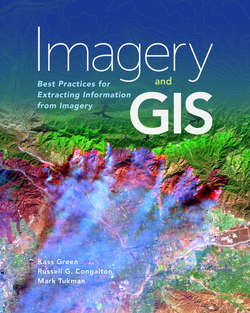Читать книгу Imagery and GIS - Kass Green - Страница 34
На сайте Литреса книга снята с продажи.
Wavelengths Sensed Passive Sensors
ОглавлениеMost images are collected by panchromatic or multispectral passive sensors that are able to sense electromagnetic energy in the visible through infrared portions of the electromagnetic spectrum. To separate different optical and midinfrared wavelengths from one another, passive remote sensors place filters or dispersing elements between the opening and the imaging surface to split different wavelengths or “bands” of the electromagnetic spectrum from one another. Filters are usually used with framing cameras and include the following:
Employing a Bayer filter over the digital array, which restricts each pixel to one portion of the electromagnetic spectrum, but alternates pixels in the array to collect at different wavelengths. The computer then interpolates the values of the non-sensed wavelengths from the surrounding pixels to simulate their values for each frequency at each pixel. This is how consumer cameras and many of the high-resolution small satellite constellations (e.g., Planet Doves) collect multispectral imagery.
Placing separate filters on multiple cameras, each filtered to accept energy from a distinct portion of the electromagnetic spectrum, allows each focal plane to be optimized for that portion of the spectrum. Many four-band (red, green, blue, and infrared) airborne image sensors (e.g., Microsoft Ultracam and Leica DMC sensors) use this approach, which requires that the images simultaneously captured with the separate cameras be coregistered to one another after capture.
Placing a spinning filter wheel in front of one camera so that each exposure of the image surface is in one portion of the electromagnetic spectrum. This approach is very useful for fixed platforms, however it requires very complex postcollection registration for systems with moving platforms and is rarely used in remote sensing systems.
Alternatively, a dispersing/splitting element can be placed between the lens and a series of CCD arrays to split the incoming energy into its discrete portions of the electromagnetic spectrum. Many multispectral and most hyperspectral sensors employ dispersing/splitting elements (e.g., Leica Airborne Digital Sensors, NASA AVIRIS).
Figures 3.6 to 3.8 illustrate how Bayer filters, framing cameras, and dispersing elements are typically used to create multispectral images. In general, because pixel values are interpolated for two values out of every three, Bayer filters will always have lower spectral resolution than multiheaded frame cameras or systems using dispersing elements.
Figure 3.6. How a Bayer filter framing camera system works. While the figure shows a true color image, Bayer filters can also be used to collect in the near-infrared portions of the electromagnetic spectrum, resulting in infrared imagery.
Figure 3.7. How a multilens multispectral framing camera system works
Figure 3.8. How a push broom multispectral scanner works with a dispersing element
